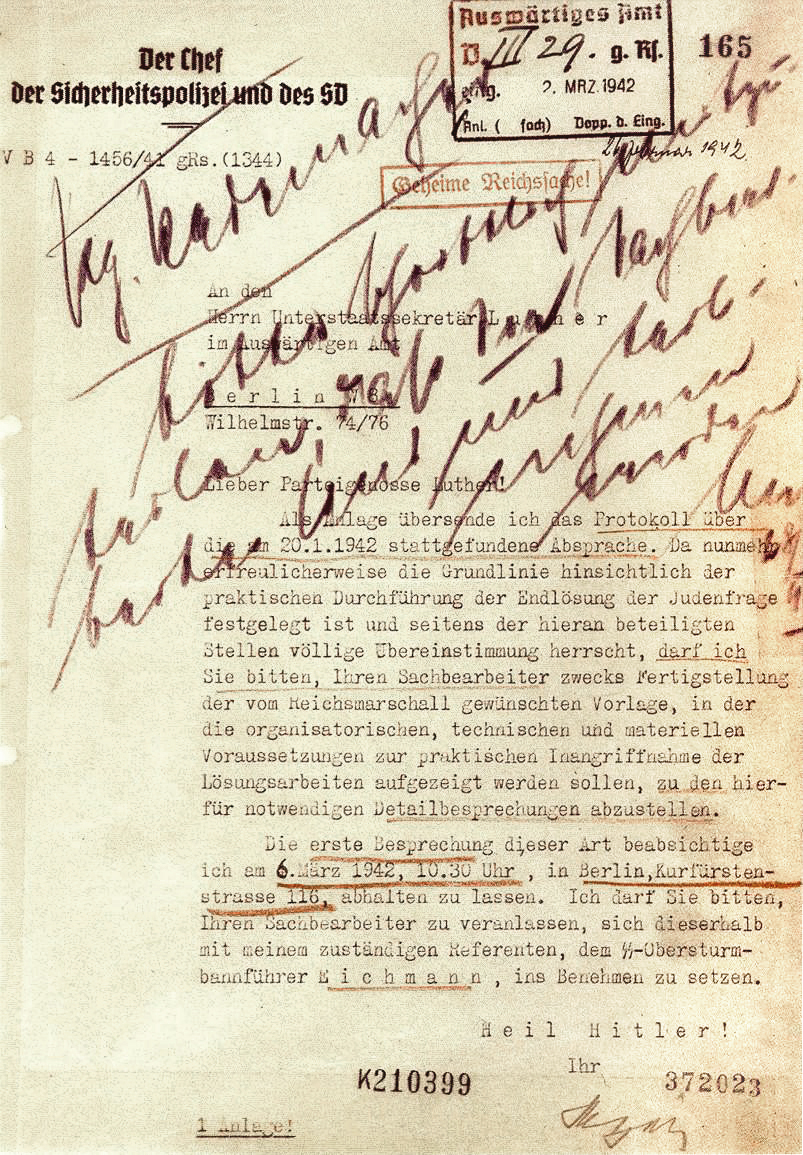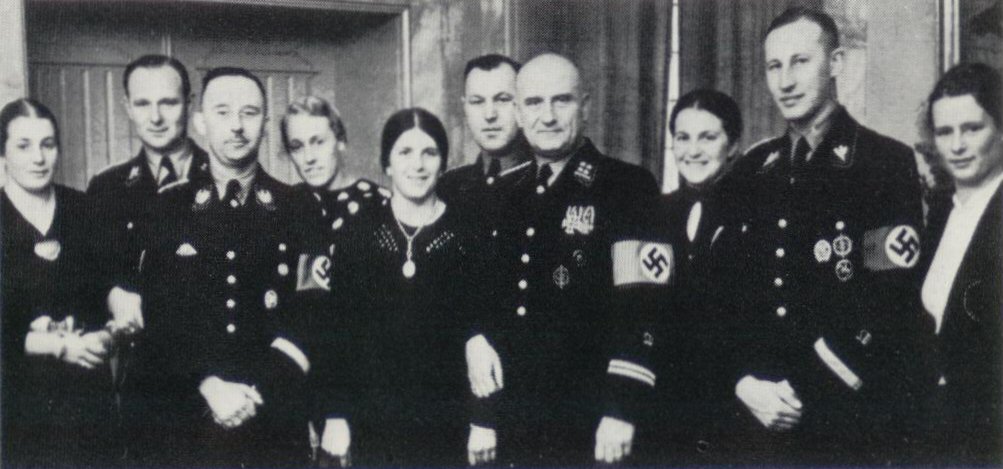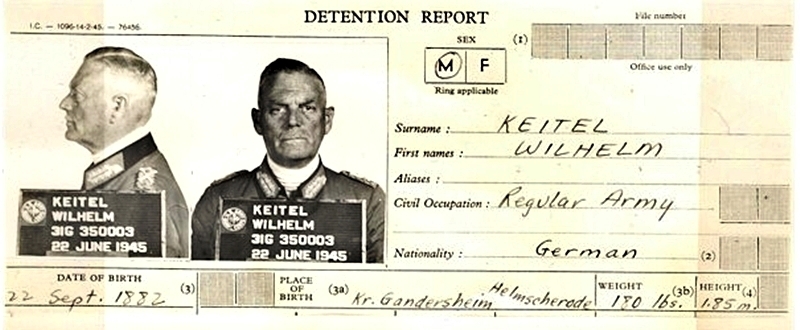|
Night And Fog Decree
''Nacht und Nebel'' ( German: ), meaning Night and Fog, also known as the Night and Fog Decree, was a directive issued by Adolf Hitler on 7 December 1941 targeting political activists and resistance "helpers" in the territories occupied by Nazi Germany during World War II, who were to be imprisoned, executed, or made to disappear, while the family and the population remained uncertain as to the fate or whereabouts of the alleged offender against the Nazi occupation power. Victims who disappeared in these clandestine actions were often never heard from again. Name The alliterative hendiadys ''Nacht und Nebel'' ( German for "Night and Fog") is documented in German since the beginning of the 17th century. It was used by Wagner in ''Das Rheingold'' (1869) and has since been adopted into everyday German (e.g., it appears in Thomas Mann's ''The Magic Mountain''). It is not clear whether the term ''Nacht-und-Nebel-Erlass'' ("Night and Fog directive") had been in wide circulation or ... [...More Info...] [...Related Items...] OR: [Wikipedia] [Google] [Baidu] |
Occupation Of Poland (1939–1945)
During World War II, Poland was occupied by Nazi Germany and the Soviet Union following the invasion in September 1939, and it was formally concluded with the defeat of Germany by the Allies in May 1945. Throughout the entire course of the occupation, the territory of Poland was divided between Nazi Germany and the Soviet Union (USSR), both of which intended to eradicate Poland's culture and subjugate its people. In the summer-autumn of 1941, the lands which were annexed by the Soviets were overrun by Germany in the course of the initially successful German attack on the USSR. After a few years of fighting, the Red Army drove the German forces out of the USSR and crossed into Poland from the rest of Central and Eastern Europe. Sociologist Tadeusz Piotrowski argues that both occupying powers were hostile to the existence of Poland's sovereignty, people, and the culture and aimed to destroy them. Before Operation Barbarossa, Germany and the Soviet Union coordinated th ... [...More Info...] [...Related Items...] OR: [Wikipedia] [Google] [Baidu] |
Intelligence Agency
An intelligence agency is a government agency responsible for the collection, Intelligence analysis, analysis, and exploitation of information in support of law enforcement, national security, military, public safety, and foreign policy objectives. Means of information gathering are both overt and covert and may include espionage, signals intelligence, communication interception, cryptanalysis, cooperation with other institutions, and evaluation of public sources. The assembly and propagation of this information is known as intelligence analysis or intelligence assessment. Objectives Intelligence agencies can provide the following services for their national governments. * Give early warning of impending crisis; * Serve national and international crisis management by helping to discern the intentions of current or potential opponents; * Inform national defense planning and military operations, known as military intelligence; * Protect sensitive information secrets, both ... [...More Info...] [...Related Items...] OR: [Wikipedia] [Google] [Baidu] |
Sicherheitsdienst
' (, "Security Service"), full title ' ("Security Service of the ''Reichsführer-SS''"), or SD, was the intelligence agency of the Schutzstaffel, SS and the Nazi Party in Nazi Germany. Established in 1931, the SD was the first Nazi intelligence organization and the Gestapo (formed in 1933) was considered its sister organization through the integration of SS members and operational procedures. The SD was administered as an independent SS office between 1933 and 1939. That year, the SD was transferred over to the Reich Security Main Office (''Reichssicherheitshauptamt''; RSHA), as one of its seven departments. Its first director, Reinhard Heydrich, intended for the SD to bring every single individual within the Third Reich's reach under "continuous supervision". Following Germany's defeat in World War II, the tribunal at the Nuremberg trials officially declared that the SD was a criminal organisation, along with the rest of Heydrich's RSHA (including the Gestapo) both individually ... [...More Info...] [...Related Items...] OR: [Wikipedia] [Google] [Baidu] |
Reinhard Heydrich
Reinhard Tristan Eugen Heydrich ( , ; 7 March 1904 – 4 June 1942) was a German high-ranking SS and police official during the Nazi era and a principal architect of the Holocaust. He held the rank of SS-. Many historians regard Heydrich as one of the darkest figures within the Nazi regime. Adolf Hitler described him as "the man with the iron heart." Heydrich was chief of the Reich Security Main Office (including the Gestapo, Kriminalpolizei (Nazi Germany), Kripo, and Sicherheitsdienst, SD). He was also (Deputy/Acting Reich-Protector) of Protectorate of Bohemia and Moravia, Bohemia and Moravia. He served as president of the International Criminal Police Commission (ICPC, now known as Interpol) and chaired the January 1942 Wannsee Conference which formalised plans for the "Final Solution to the Jewish question"—the deportation and genocide of all Jews in German-occupied Europe. He was the founding head of the (Security Service, SD), an intelligence organisation charg ... [...More Info...] [...Related Items...] OR: [Wikipedia] [Google] [Baidu] |
Bundesarchiv Bild 183-H30220, Wilhelm Keitel
The German Federal Archives or Bundesarchiv (BArch) (, lit. "Federal Archive") are the national archives of Germany. They were established at the current location in Koblenz in 1952. They are subordinated to the Federal Commissioner for Culture and the Media (Claudia Roth since 2021) under the German Chancellery, and before 1998, to the Federal Ministry of the Interior. On 6 December 2008, the Archives donated 100,000 photos to the public, by making them accessible via Wikimedia Commons. History The federal archive for institutions and authorities in Germany, the first precursor to the present-day Federal Archives, was established in Potsdam, Brandenburg in 1919, a later date than in other European countries. This national archive documented German government dating from the founding of the North German Confederation in 1867. It also included material from the older German Confederation and the Imperial Chamber Court. The oldest documents in this collection dated back to the y ... [...More Info...] [...Related Items...] OR: [Wikipedia] [Google] [Baidu] |
Operation Barbarossa
Operation Barbarossa was the invasion of the Soviet Union by Nazi Germany and several of its European Axis allies starting on Sunday, 22 June 1941, during World War II. More than 3.8 million Axis troops invaded the western Soviet Union along a front, with the main goal of capturing territory up to a line between Arkhangelsk and Astrakhan, known as the A-A line. The attack became the largest and costliest military offensive in history, with around 10 million combatants taking part in the opening phase and over 8 million casualties by the end of the operation on 5 December 1941. It marked a major escalation of World War II, opened the Eastern Front—the largest and deadliest land war in history—and brought the Soviet Union into the Allied powers. The operation, code-named after the Holy Roman Emperor Frederick Barbarossa ("red beard"), put into action Nazi Germany's ideological goals of eradicating communism and conquering the western Soviet Union to repopulate it w ... [...More Info...] [...Related Items...] OR: [Wikipedia] [Google] [Baidu] |
Wilhelm Keitel
Wilhelm Bodewin Johann Gustav Keitel (; 22 September 188216 October 1946) was a German field marshal who held office as chief of the (OKW), the high command of Nazi Germany's armed forces, during World War II. He signed a number of criminal orders and directives that led to numerous war crimes. Keitel's rise to the high command began with his appointment as the head of the Armed Forces Office at the Reich Ministry of War in 1935. Having taken command of the in 1938, Adolf Hitler replaced the ministry with the OKW and Keitel became its chief. He was reviled among his military colleagues as Hitler's habitual " yes-man". After the war, Keitel was indicted by the International Military Tribunal in Nuremberg as one of the "major war criminals". He was found guilty on all counts of the indictment: crimes against humanity, crimes against peace, criminal conspiracy, and war crimes. He was sentenced to death and executed by hanging in 1946. Early life and career Wilhelm Keite ... [...More Info...] [...Related Items...] OR: [Wikipedia] [Google] [Baidu] |
Generalfeldmarschall
''Generalfeldmarschall'' (; from Old High German ''marahscalc'', "marshal, stable master, groom"; ; often abbreviated to ''Feldmarschall'') was a rank in the armies of several German states and the Holy Roman Empire, (''Reichsgeneralfeldmarschall''); in the Habsburg monarchy, the Austrian Empire and Austria-Hungary, the rank ''Feldmarschall'' was used. The rank was the equivalent to ''Großadmiral'' () in the '' Kaiserliche Marine'' and ''Kriegsmarine'', a five-star rank, comparable to OF-10 in today's NATO naval forces. Austrian Empire and Austria-Hungary Paroli (uniform) The rank existed in the Austrian Empire as ''Kaiserlicher Feldmarschall'' ("imperial field marshal") and in Austria-Hungary as '' Kaiserlicher und königlicher Feldmarschall'' - ''Császári és királyi tábornagy'' ("imperial and royal field marshal"). Both were based on prior usage during the Holy Roman Empire. The Emperor-King held the rank ''ex officio'', other officers were promoted as required. Betw ... [...More Info...] [...Related Items...] OR: [Wikipedia] [Google] [Baidu] |
Gestapo
The (, ), Syllabic abbreviation, abbreviated Gestapo (), was the official secret police of Nazi Germany and in German-occupied Europe. The force was created by Hermann Göring in 1933 by combining the various political police agencies of Free State of Prussia, Prussia into one organisation. On 20 April 1934, oversight of the Gestapo passed to the head of the ''Schutzstaffel'' (SS), Heinrich Himmler, who was also appointed Chief of German Police by Hitler in 1936. Instead of being exclusively a Prussian state agency, the Gestapo became a national one as a sub-office of the (SiPo; Security Police). From 27 September 1939, it was administered by the Reich Security Main Office (RSHA). It became known as (Dept) 4 of the RSHA and was considered a sister organisation to the (SD; Security Service). The Gestapo committed widespread atrocities during its existence. The power of the Gestapo was used to focus upon political opponents, ideological dissenters (clergy and religious org ... [...More Info...] [...Related Items...] OR: [Wikipedia] [Google] [Baidu] |
Heinrich Himmler
Heinrich Luitpold Himmler (; 7 October 1900 – 23 May 1945) was a German Nazism, Nazi politician and military leader who was the 4th of the (Protection Squadron; SS), a leading member of the Nazi Party, and one of the most powerful people in Nazi Germany. He is primarily known for being one of the main architects of the Holocaust. After serving in a reserve battalion during World War I without seeing combat, Himmler went on to join the Nazi Party in 1923. In 1925, he joined the SS, a small paramilitary arm of the Nazi Party that served as a bodyguard unit for Adolf Hitler. Subsequently, Himmler rose steadily through the SS's ranks to become by 1929. Under Himmler's leadership, the SS grew from a 290-man battalion into one of the most powerful institutions within Nazi Germany. Over the course of his career, Himmler acquired a reputation for good organisational skills as well as for selecting highly competent subordinates, such as Reinhard Heydrich. From 1943 onwards, ... [...More Info...] [...Related Items...] OR: [Wikipedia] [Google] [Baidu] |
Reichsführer-SS
(, ) was a special title and rank that existed between the years of 1925 and 1945 for the commander of the (SS). ''Reichsführer-SS'' was a title from 1925 to 1933, and from 1934 to 1945 it was the highest Uniforms and insignia of the Schutzstaffel, rank of the SS. The longest-serving and most noteworthy office holder was Heinrich Himmler. Definition was both a title and a rank. The title of was first created in 1926 by the second commander of the SS, Joseph Berchtold. Julius Schreck, founder of the SS and Berchtold's predecessor, never referred to himself as . Yet, the title was retroactively applied to him in later years. In 1929, Heinrich Himmler became and referred to himself by his title instead of his regular SS rank of . This set the precedent for the commander of the SS to be called . Prior to the Night of the Long Knives, the SS was an elite corps of the (SA or storm troopers), and the was subordinate to the SA's operating head, the . On 20 July 1934, as part ... [...More Info...] [...Related Items...] OR: [Wikipedia] [Google] [Baidu] |







